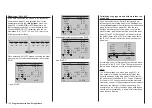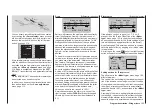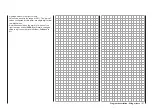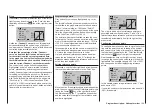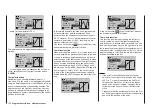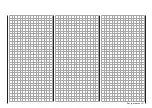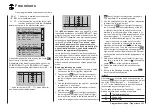
194 Program description - Helicopter mixer
therefore, you can modify the mixer at any time and
preset both symmetrical and asymmetric mixer ratios
both above and below the hover point. Before you do,
however, ensure you have entered the correct direc-
tion of rotation for the main rotor on the »Helicopter
type« menu.
+100%
+30%
Tail
C1
normal
H
+30%
Input
Output
Point
Curve off
Starting with values of -30 % for point “L” and +30 %
for point “H”, the mixer is to be configured in such a
way that the helicopter, even during prolonged verti-
cally ascending or descending flights, does not devi-
ate from the yaw axis as a result of the main rotor’s
altered torque while hovering. For hovered flight, trim
should only be affected by way of the (digital) tail rotor
trim lever.
For a reliable torque compensation setting, it is es-
sential that the collective pitch and throttle curves
have been set up correctly, i. e. that the rotor speed
remains constant over the collective pitch’s full adjust-
ment range.
This third curve mixer applies only to the control
curve of the tail rotor servo when the throttle/collec-
tive pitch stick is moved, whereas the “Channel 1
curve”, see page 141, acts on all servos that are
affected by the throttle/collective pitch stick. Note that
the output signal of the “Channel 1 curve” option also
functions as an input signal for the tail rotor curve
programmed here: In the graph, the vertical line is
synchronized with the throttle/collective pitch stick
and follows the current Channel 1 curve characteristic
from the »Channel 1 curve« menu.
In the auto-rotation flight phase this mixer is auto-
matically switched off.
Roll
Throttle and Nick
Throttle
0%
0%
SEL
0%
0%
normal
C1
Tail
Tail
Roll
Throttle
Roll
Throttle
Tail
Nick
Throttle
Increasing collective pitch is not the only change that
requires the throttle to follow suit: major cyclic control
movements also require this, i. e. if the swashplate is
tilted in any direction. The program of the transmitters
mc-16
HoTT and
mc-20
HoTT lets you adjust
the degree of throttle follow separately for roll and
pitch-axis controls.
This offers particular advantages in aerobatic flying,
e. g. when flying a roll: here, with moderate collective
pitch values and the carburetor only about half-open,
cyclic control travels are nonetheless executed that
require much higher performance from the motor.
The mixer value can be varied within the range 0 to
+100 %. The correct mixer direction is automatically
taken into account.
A simultaneous tap on the
or
keys of the
right four-way button (CLEAR) will reset a changed
value in an active (inverse video) field back to 0 %.
In the auto-rotation flight phase this mixer is auto-
matically switched off.
Tail
Throttle
Pitch
0%
0%
SEL
normal
C1
C1
Throttle
Tail
Tail
Roll
Throttle
Throttle
While the tail rotor normally compensates for the
effect of main rotor torque on the fuselage, it is also
used to control the helicopter around the vertical axis.
Increasing tail rotor thrust requires a corresponding
adjustment to motor power, however, to avoid a fall-off
in system rotational speed.
This mixer sets the extent to which the throttle follows
the tail rotor. The throttle will follow on one side only,
to the side on which the tail rotor thrust is increased.
The setting range is therefore 0 to +100 %. The direc-
tion depends on the main rotor’s direction of rotation
(left or right), and this must first be set correctly on
the »Helicopter type« menu. For left-hand rotation
systems, the throttle follows the tail rotor when the
tail rotor stick is moved to the left, and vice versa for
right-hand rotation systems.
A simultaneous tap on the
or
keys of the
right four-way button (CLEAR) will reset a changed
value in an active (inverse video) field back to 0 %.
In the auto-rotation flight phase this mixer is auto-
matically switched off.
Set-up notes:
To set the mixer value accurately you should either
first fly several high-speed pirouettes against the
direction of main rotor rotation or, if a strong wind is
blowing, hover at right angles to the wind with a suf-
ficiently large tail rotor deflection. Set the mixer value
so that there is no fall-off in system rotational speed.
Summary of Contents for HoTT MC-16 Series
Page 1: ...Programming Manual mc 16 mc 20 HoTT 1 en mc 16 mc 20...
Page 27: ...27 For your notes...
Page 53: ...53 For your notes...
Page 61: ...61 For your notes...
Page 65: ...65 For your notes...
Page 71: ...71 For your notes...
Page 103: ...103 For your notes...
Page 107: ...107 For your notes...
Page 111: ...111 For your notes...
Page 155: ...155 For your notes...
Page 165: ...165 For your notes...
Page 201: ...201 For your notes...
Page 229: ...229 For your notes...
Page 231: ...231 For your notes...
Page 261: ...261 For your notes...
Page 265: ...265 For your notes...
Page 301: ...301 For your notes...
Page 327: ...327 For your notes...
Page 328: ...328 For your notes...

